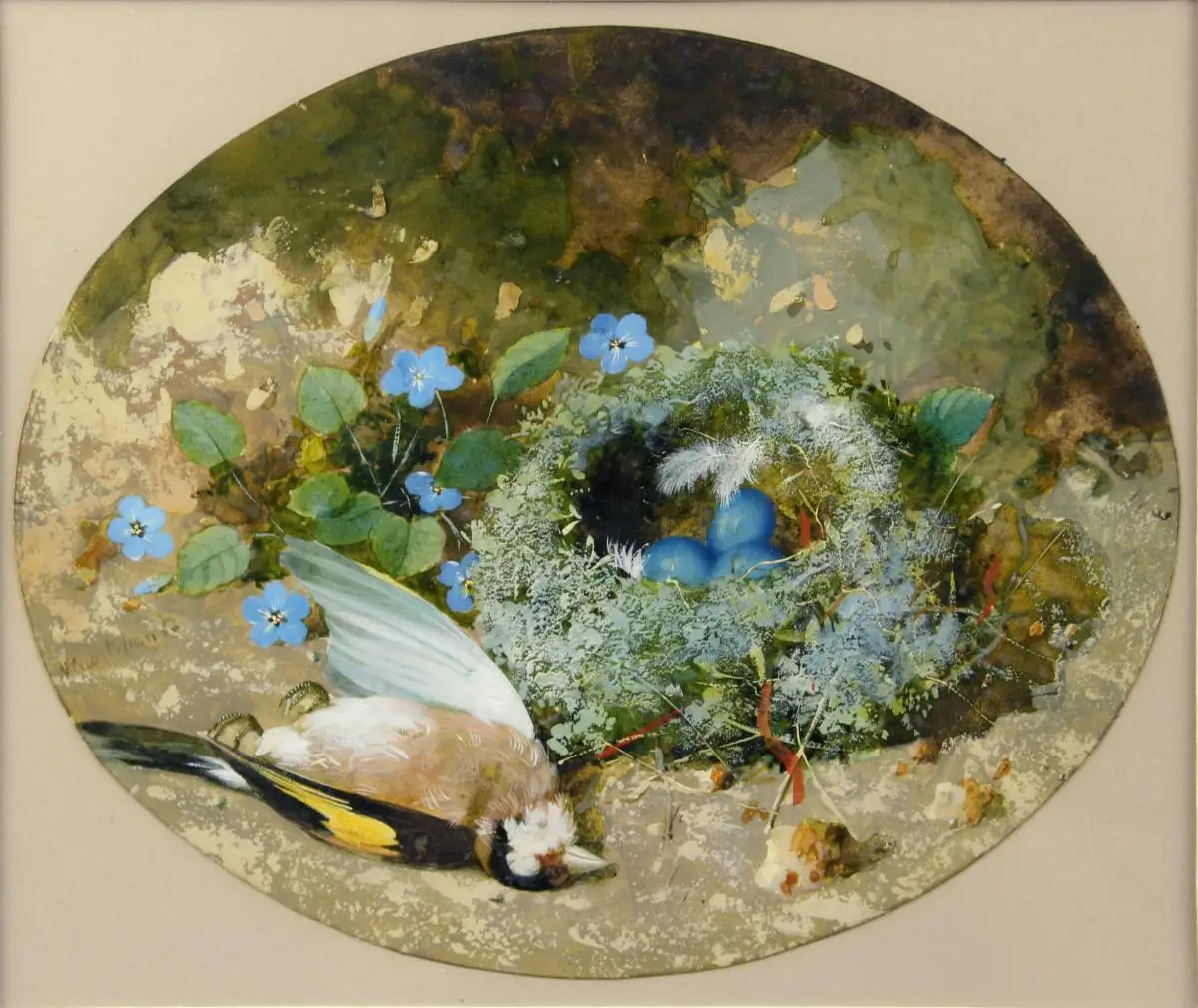- Preis:
-
980,00
- Zustand:
- Originalkunstwerk aus der Zeit
- Versand und Zahlung:
-
AGBs
Versandbedingungen
Zahlungsbedingungen
William Cruickshank (19 Jh.). Stilleben mit totem Stieglitz und Nest. Aquarell und Gouache auf chamoisfarbenem Papier, 21 x 24,5 cm (Sichtmaß), 40 x 42 cm (Rahmen), linksseitig signiert „W Cruickshank“. Hinter Glas im Passpartout gerahmt.
zum Werk
Das Bild verströmt die Atmosphäre einer melancholischen Schönheit. Das Gelege mit den an das wunderbar geheimnisvolle Blau der Romantik gemahnenden Eiern, die dazu passenden blauen Blumen und der Stieglitz mit seinem schwarz-gelb-rotem Gefieder zeigen die Natur in ihrer ganzen Schönheit und doch ist der Stieglitz tot. Er liegt auf dem Rücken, der Kopf ist in unnatürlicher Weise nach hinten geknickt, die Krallen sind leblos in sich zusammengesunken und der eine Flügel in letzter Anstrengung weit aufgefächert. Dadurch wird die Szenerie zu einer natura morta, zu einem Stilleben, das die melancholische Stille eines ewigen Augenblicks verbreitet. Und doch wohnt dem Bild auch eine Bewegung inne, die durch den schlierenartigen Farbauftrag befördert wird.
Eine Bewegung, die hier das Ineinandergreifen von Leben und Tod bedeutet: Der Tod, den der Stieglitz mitten im Leben ereilt hat noch bevor er den Nachwuchs ausbrüten konnte, während die nicht ausgebrüteten geheimnisvoll blauen Eier zugleich auf ein höheren Leben nach dem Tode verweisen. Schließlich steht der sich von den dornigen Disteln ernährende Stieglitz traditionell für Christus und dessen erlösendem Opfertod ein. In einer vergleichbaren, von der unmittelbaren Veranschaulichung Christi losgelösten Szenerie findet sich der Stieglitz auf dem berühmten, im Mauritshuis in Den Haag aufbewahrten Bild Der Distelfink (1654) von Carel Fabritius. Dort lebt der Vogel zwar, ist aber angekettet und wird so am Fliegen gehindert.
In dieser Traditionslinie stehend ist das Bild Cruickshanks ein auch den heutigen Betrachter unmittelbar ansprechendes memoto mori - ein Meditationsbild über Leben und Tod, das zugleich eine Bejahung des Lebens in der ganzen Schönheit der Schöpfung beinhaltet. Um die Lesbarkeit dieses Bildsinns zu verstärken, sind die dargestellten Gegenstände in die Fläche gekippt, so dass sich die einzelnen Bildelemente leichter aufeinander beziehen lassen, ohne dass dadurch der räumliche Eindruck jedoch aufgehoben werden würde.
Cruickshank, der sich auf derartige Bilder spezialisiert hat, verbindet die Emblematik des Barock mit der Bildsprache der Romantik und einem der Landschaftsmalerei entlehnten Duktus. Hierin zeigt sich die meisterhafte Materialbeherrschung Cruickshanks, der die Technik des Aquarells mit der Gouache so verschmilzt, dass sich das Motiv aus einem unbestimmten, in sich bewegten Farbraum heraus durch die intensiveren Farben der Gouache konkretisiert, wobei die ausgeführten Bildgegenstände die ästhetische Qualität der Feinmalerei aufweisen, obwohl diese - wie beispielsweise das Nest - durch eine virtuose Fleckenstruktur gebildet werden.
Auswahlbibliographie
Algernon Graves: The Royal Academy of Arts. A complete dictionary of contributors and their work from its foundation in 1769 to 1904, vol. 2: Carroll to Dyer, London 1905.
Leo R. Schidlof: The miniature in Europe. In the 16th, 17th, 18th, and 19th centuries, vol. 1: A - L, Graz 1964.
Jeremy Maas: Victorian painters, London 1996.
Daphne Foskett: A Dictionary of British miniature painters, London 1972.
Jane Johnson: Works exhibited at the Royal Society of British Artists, 1824 - 1893. An Antique Collectors' Club research project, vol. 1: A - P, Woodbridge 1975.
Adrian Vincent: A companion to Victorian and Edwardian artists, Newton 1991.
Auswahl an öffentlichen Sammlungen Werke von William Cruickshank besitzen
Brighton Museum and Art Gallery, Harris Museum and Art Gallery Preston.
ENGLISH VERSION
William Cruickshank (19th century). Still Life with a Dead Goldfinch and Nest. Watercolour and gouache on buff paper, 21 x 24.5 cm (visible size), 40 x 42 cm (frame), signed W Cruickshank on the left. Framed behind glass in a passpartout.
About the artwork
The painting has an atmosphere of melancholy beauty. The clutch of eggs, recalling the wonderfully mysterious blue of Romanticism, the matching blue flowers and the goldfinch with its black, yellow and red plumage show nature in all its beauty, and yet the goldfinch is dead. It lies on its back, its head bent backwards in an unnatural way, its claws lifeless and one wing outstretched in a last effort. This makes the scene a natura morta, a still life that spreads the melancholy silence of an eternal moment. Yet there is also an inherent movement in the picture, enhanced by the streaky application of paint.
A movement that here signifies the intertwining of life and death: death, which the goldfinch has met in mid-life, before it has been able to hatch its offspring, while at the same time the mysterious blue eggs that have not hatched point to a higher life after death. Finally, the goldfinch feeding on the thorny thistles traditionally represents Christ and his redemptive sacrificial death. The goldfinch is depicted in a similar way in Carel Fabritius' famous painting The Thistle Finch (1654), in the Mauritshuis in The Hague. The bird is alive, but chained and thus prevented from flying.
In this tradition, Cruickshanks' painting is a memento mori that is immediately appealing to today's viewer - a meditative image of life and death that also contains an affirmation of life in all the beauty of creation. In order to enhance the readability of this pictorial sense, the objects depicted are tilted into the plane so that the individual elements of the picture can be more easily related to one another, but without destroying the sense of space.
Cruickshank, who specialised in this type of painting, combined the emblematics of the Baroque with the imagery of Romanticism and a style borrowed from landscape painting. Cruickshank's mastery of materials is evident in his fusion of watercolour and gouache, in which the more intense colours of gouache concretise the motif from an indeterminate, moving colour space. The painted objects have the aesthetic quality of fine painting, although, as in the case of the nest, they are formed by a virtuoso structure of blotches.
Selected bibliography
Algernon Graves: The Royal Academy of Arts. A complete dictionary of contributors and their work from its foundation in 1769 to 1904, vol. 2: Carroll to Dyer, London 1905.
Leo R. Schidlof: The miniature in Europe. In the 16th, 17th, 18th, and 19th centuries, vol. 1: A - L, Graz 1964.
Jeremy Maas: Victorian painters, London 1996.
Daphne Foskett: A Dictionary of British miniature painters, London 1972.
Jane Johnson: Works exhibited at the Royal Society of British Artists, 1824 - 1893. An Antique Collectors' Club research project, vol. 1: A - P, Woodbridge 1975.
Adrian Vincent: A companion to Victorian and Edwardian artists, Newton 1991.
Selection of public collections holding works by William Cruickshank
Brighton Museum and Art Gallery, Harris Museum and Art Gallery Preston.
- Lagernummer:
- Z-C001
- Artikelstandort:
- DE-13353 Berlin
- Bezahlarten
-
Vorauskasse Überweisung
Barzahlung bei Abholung
Rechnung für Institutionen
- Lieferfristen
-
Deutschland
Standard
2 bis 10 Werktage Europa
Standard
4 bis 14 Werktage weltweit
Standard
12 bis 28 Werktage - Versandkosten inkl. Verpackung
- Für den Versand nach Deutschland: EUR 0
'Alle Artikelkategorien' gestaffelt nach Gewicht
| Gewicht in g | Innerhalb des Landes | Innerhalb der EU | Rest-Europa | Weltweit |
|---|---|---|---|---|
| bis 20000 | 0,00 € | 20,00 € | 50,00 € | 80,00 € |
| darüber | 25,00 € | 50,00 € | 80,00 € | 120,00 € |
- Verkäuferinfo:
- Arcadia-Art
- Land:
-
 Deutschland
Deutschland - Status:
- gewerblich
- Mitglied seit:
-
Deprecated: Function strftime() is deprecated in /var/www/antik/templates/Marketplace/NotAvailable.php on line 330
2023





 weitergeleitet.
weitergeleitet.
